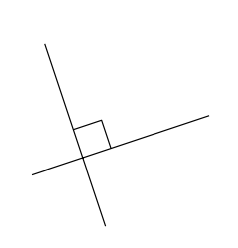5.1: Right, Acute and Obtuse Angles
- Page ID
- 23605
- If \(|\measuredangle AOB| = \dfrac{\pi}{2}\), we say that \(\angle AOB\) is right;
- If \(|\measuredangle AOB| < \dfrac{\pi}{2}\), we say that \(\angle AOB\) is acute;
- If \(|\measuredangle AOB| > \dfrac{\pi}{2}\), we say that \(\angle AOB\) is obtuse.

On the diagrams, the right angles will be marked with a little square, as shown.
If \(\angle AOB\) is right, we say also that \([OA)\) is perpendicular to \([OB)\); it will be written as \([OA) \perp [OB)\). From Theorem 2.4.1, it follows that two lines \((OA)\) and \((OB)\) are appropriately called perpendicular, if \([OA) \perp [OB)\). In this case we also write \((OA) \perp (OB)\).
Assume point \(O\) lies between \(A\) and \(B\) and \(X \ne O\). Show that \(\angle XOA\) is acute if and only if \(\angle XOB\) is obtuse.
- Hint
-
By Axiom IIIb and Theorem 2.4.1, we have \(\measuredangle XOA - \measuredangle XOB \equiv \pi\). Since \(|\measuredangle XOA|, |\measuredangle XOB| \le \pi\), we get that \(|\measuredangle XOA| + |\measuredangle XOB| = \pi\). Hence the statement follows.


